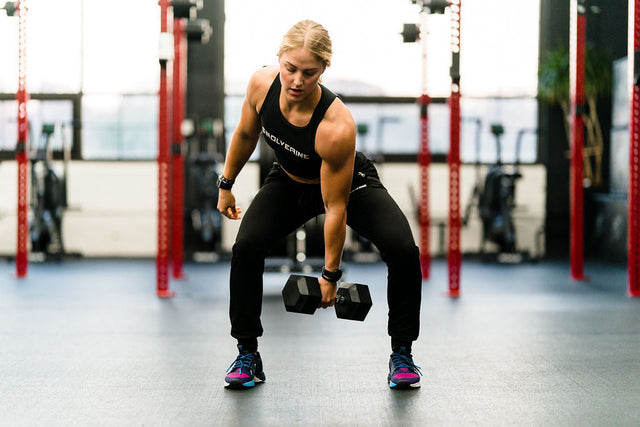Most of us share a common goal when we fitness and train – building more strength and muscle, and lots of it. There are many different opinions and theories when it comes to the most optimal range of reps, whether it’s lifting heavy weight for low reps, moderate weight for moderate reps, or light weight for high reps, each training regimen has a method to its madness. With the inspired fair share of fads and pseudoscience, we’re going to take a closer look at exactly what rep scheme: high rep vs low rep training, will take your fitness to the next level.
High Rep Vs Low Rep Training: Which One Is Best
Any resistance training program will help develop strength, so long as the loaded weight is sufficient to force neuromuscular development - this is referred to as neural demand. Neural demand refers to the challenge an exercise places on the balance and stabilization of the kinetic chain. Functional training with sufficient progressive overload, or stress on the muscular system will alter the foundation of functional strength, joint stability, mobility, and coordination.
To achieve maximal strength and hypertrophy you shouldn’t be guessing when it comes to your training. To achieve the desired results and reach your goals, you need to have an evidence-based approach with program specificity when deciding on how many reps whether high or low to program.
RELATED ARTICLE How To Get Stronger In 3 Simple Steps
High Rep Vs Low Rep Training: Building Strength
Resistance training program variables such as reps, sets, intensity, tempo, and volume, dictate the outcomes of your training program. Strength and muscle mass are linearly correlated, meaning the more hypertrophic your training, the more strength you’ll gain. Strength is the ability of the nervous system to recruit muscle fibers when needed, to produce initial tension, to overcome an external force. Strength is a neuromuscular adaptation, largely dependent upon the mind muscle connection.
For muscular strength to occur, exertion and stress needs to placed on the muscle fibers, leading to damage and fatigue. Intensity must be high enough to exert stress, but low enough to finish the rep protocol and allow sufficient reps to exhaustion.
Training for maximal strength occurs with higher levels of intensity, which is inversely related to reps. Thus, the higher level of intensity, the lower number of reps performed.
For maximal strength, research conclusively shows that low reps with heavy weight vs high reps with low weight will elicit the most strength gains. That’s not to say however that strength does not occur with high rep protocols, that prescribe more volume. Intensity is also crucial when it comes to building strength. With less prescribed reps, intensity will need to increase. Resistance exercise intensity is commonly prescribed as a percent of 1 repetition maximum (1RM). Therefore, strength will occur with a prescribed 1-5 reps, at 80-90% of your one rep max (1RM).
High Rep Vs Low Rep Training: Building Muscle (Hypertrophy)
Hypertrophy training is specific to maximal muscle growth, focusing on high volume (reps, sets, load, intensity) with minimal rest periods to force adaptation. The consensus and prescribed rep scheme for building more muscle mass, is between 8-12 reps and 3-5 sets at 70-80% of your 1RM. Assuming you’re lifting to failure, more muscle will be developed when volume is increased, allowing more muscle stimulation and muscular endurance. High reps also stimulate muscle growth and typically range between 15-20 reps. Although there is no “prescribed” or optimal rep range, if you can actively surpass your lactic threshold and delay muscle fatigue, increasing workout volume, at the same intensity, of a moderate rep range at 70-80% you will build more muscle mass. Supplements such as Beta-Alanine, a natural lactic acid buffer, can help delay muscle fatigue, increase time to exhaustion, and improve workout volume.
RELATED ARTICLE 8 Week Muscle Building Workout Program
Once your body begins to adapt to high rep schemes, it’s important to continuously progress, by adding heavier loads to the bar, to stimulate adaptation and hypertrophy.
High Rep Vs Low Rep Training: Fat Loss
Optimal weight loss will solely depend on two critical factors when it comes to your training regimen - volume and intensity. Intensity is more important than the specific rep count when it comes to dropping body fat. Beginners should aim for more volume, with a rep range between 12-15 per set, building more functional strength, stability and mobility. Seasoned lifters will decide upon what volume, they need based upon growth, muscle imbalances, weak areas of focus, and areas for better muscle development.
Volume will help increase body fat and burn more calories, due to more workload, and time under tension. Aim for at least 4-5 sets, of moderate intensity of 12-15 reps per set. Nutrition however is also a vital factor when it comes to weight loss. Being in a caloric deficit, eating less calories than you burn, will result in weight loss over time. If you want the most optimal results, then we recommend hiring a 1:1 nutrition coach to write you a customized nutrition plan for the most systemic approach.
Optimal Rep Ranges: Linear and Undulating Periodization
There is no, best method to prescribed high rep vs low rep training protocols. An optimal mix of low reps heavy weight, with moderate weight and moderate to high reps, will provide the most optimal outcomes. When you're first starting, following a linear periodization with initial high volume, and low intensity, increasing intensity over time, will provide the most progression. Undulating periodization, or changing volume and intensity between strength, hypertrophy, and endurance training, will achieve the best muscular adaptations and gains.
Need Help With Optimizing Your Nutrition And Training Plan To Finally Get The Results You've Been Waiting For?
The Swole Kitchen is an exclusive membership opportunity for those who are looking to pursue a performance-driven lifestyle. By combining wellness consulting, nutritional lifestyle improvement, and 1:1 customized nutrition plans to our members, our programs aim to optimize human potential. In each of our programs, you’ll receive guidance to reclaim your health, fuel your lifestyle, and pursue performance ambitions, all while learning how to make nutritional decisions from a place of self-trust and intuition. All of our coaches are committed to providing the highest level of results-driven wellness to our members.

SWOLVERINE IS AN ENDURANCE ATHLETE AND ACTIVE LIFESTYLE BRAND. MADE FOR THE ELITE ATHLETE, AND THE STRONG-WILLED OUR PRODUCTS WERE DESIGNED TO FUEL YOUR ATHLETIC PERFORMANCE. WE PERFORM WHEN YOU PERFORM.
We believe that everyone can optimize not only their athletic performance but their human potential. The way we believe we can optimize performance is through transparency, clinically effective doses, and clinically proven ingredients with evidence-based outcomes. We provide the nutrients you need to power your active lifestyle.









